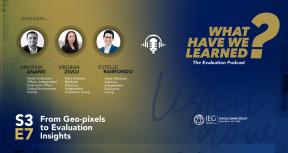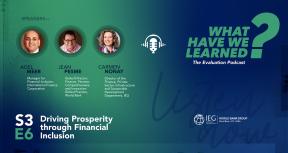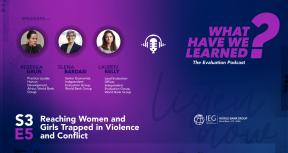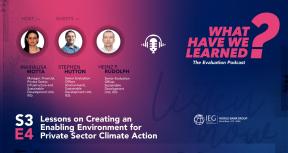More than a billion people live in areas affected by fragility, conflict, and violence. Climate change and the COVID pandemic threaten to drive that number even higher. How have the World Bank Group and the range of actors involved in development adapted to address new and persistent sources of insecurity, and what are the lessons for future efforts aimed at fostering development and stability?
Host Brenda Barbour speaks with Sarah Cliffe, Director at the Center on International Cooperation at New York University.
Listen on Spotify, or Apple Podcasts.
Related Resources:
IEG's Evaluation, World Bank Engagement in Situations of Conflict
The blog series Learning from Fragility explores lessons from past support for development in fragile and conflict settings. The series includes:
TRANSCRIPT
Brenda: Development has always been closely linked with conflict and insecurity. The International Bank for Reconstruction and Development, which later became the World Bank, was founded during the Second World War. The aim was for Reconstruction and Development to promote peace and stability. Today, more than a billion people live in areas affected by fragility conflict and violence, climate change, and the COVID pandemic threatened to drive that number even higher. How have the World Bank Group in the range of actors involved in development, adapted to address new and persistent sources of insecurity? And what are the lessons for future efforts aimed at fostering development and stability?
Welcome to What Have We Learned? The Evaluation Podcast. I'm your host Brenda Barbour of the World Bank Group's independent evaluation arm, IEG. I will be exploring the evolution of the development approach to fragility and conflict with my guest, Sarah Cliffe, currently the director of New York University's Center on International Cooperation, and who previously was the Special Representative for the World Bank's 2011 World Development Report on Conflict, Security and Development. Sarah also has extensive experience working on reconstruction in post conflict countries with the World Bank and the United Nations. Welcome, Sarah, to What Have We Learned?
Sarah: Hello, Brenda, glad to be with you.
Brenda: Well, let's dive in. The 2011 World Development Report (WDR) on conflict, security and development is a great place to start. As we explore how development organizations have been adapting to the growth of insecurity, can you explain the shift in thinking that report represented?
Sarah: Thank you, Brenda, I think the WDR represented a shift in thinking on four different factors: on risk factors, on the role of institutions, on future patterns of conflict, and perhaps most importantly, on solutions. All of this, of course, built on a great deal of existing work in academia, in the Bank and in other institutions. But these are the four shifts I would point to. So, the WDR was amongst the first to look at risk factors which we call stressors across the security, economic and justice fields. Some were well known before the WDR, like low income levels and natural resource wealth, but some were newly researched and linked presented together in the WDR. And those included human rights, for instance, evidence that a reduction in political prisoners or extra judicial killings, makes conflict two to three times less likely. Discrimination and inequality between groups makes conflict more likely. And that's a factor which the later World Bank-UN study Pathways for Peace expanded on very effectively.
We looked at the role of corruption, which had previously been less linked to conflict and found very robust evidence that higher levels of corruption increase conflict risk. We looked at rapid urbanization, which is a growing risk when you look for instance, at regions such as Africa, which are going through rapid urban urbanization, a growing risk for violence, and perhaps most importantly, we considered external interference and occupation as explicit stressors, explicit causes of conflict, and this emphasis on the national and international together was quite new in mainstream development literature, although familiar, of course, in political science. Particularly important to look at those factors now, as we see the current situation in Ukraine. Our findings in fact, show occupation over time dramatically increases conflict risk, it is not a factor which causes a return of law and order and stability.
Sarah: We then looked at the key role of institutions considered broadly, norms of behavior, networks, organizations. And here we can think of a comparison. So, our basic point was the countries with strong institutions, that are accountable, legitimate, high capacity, can withstand higher levels of risk. So, if you make a comparison between say a country like Spain and a country like Haiti, Spain has gone through a lot of risks actually. Very high youth unemployment levels, independence and separatist movement pressures, some issues of scandals in the institutions and so forth, but Spain has not gone towards conflict. A country like Haiti, by contrast with much weaker institutions would with a similar or lower level of risk, be at much greater probability of facing conflict and violence.
Third factor that I believe was a shift is that we looked at future patterns. And we identified rising conflict risk in middle income countries and internationally. And this was already a trend that was happening when the WDR was published. But it was something which really challenged the idea that it was only the lowest income, the poorest countries that were likely to face this. What we've seen in the more than 10 years since the publication of the WDR, is that indeed, middle income countries and high income countries to some degree, have been at risk.
Sarah: The last and most important shift was on solutions. So, the WDR drew on more than 70 case studies and input papers to identify common patterns for countries that successfully executed from fragility like Ghana or Indonesia. These countries typically focused on just a few results, not trying to achieve 80 or 90 results, but just two or three key results, that build confidence in the delivery, the accountability and the inclusiveness of national institutions. And then they've gradually built institutions to be able to scale up those results, and resist pressures over time.
We also showed that it took a long time. So, we looked at the average time taken for countries to move from the governance level of again, roughly Haiti, to the governance level of roughly Ghana. And on most indicators, like government capacity, accountability, military, and politics, and so forth, it took between 30 and 40 years to make that shift.
I've actually just returned from the Democratic Republic of Congo (DRC). And I see those points quite clearly in the challenges DRC is facing. So, the fact that it takes time to build institutions, the need to deliver a few actions, real tangible, visible results, and then to gradually institutionalize around them.
Brenda: Thank you. I want to follow up on some of the things you said, because I'm really interested, especially the example comparing Spain to Haiti, and how the weak institutions are really the thing that make it hard to deal with the stressors. And so, what are some of the things that you've seen that help strengthen institutions?
Sarah: So, one thing I think, is to focus on achieving a fairly narrow set of practical results from institutions, and then repeat that process over and over again, rather than what we often see in conflict affected countries, which is grand plans to reform every part of their institutions all at once. Now, we know that in the most fragile countries, there are many institutional deficits. So, it's tempting perhaps, to think “let's try to transform everything.” But in fact, the problem from most fragile countries is not really the technical solutions to institutional reform, it's that there are great political barriers, political economy, interests against reform.
Sarah: So, it's very difficult to try to move forward on too many fronts at once. And I think the lessons of success show that choosing your battles wisely, and picking some areas of institutional reform, which will deliver results, and which will show people tangibly that their state is actually providing for them and holding people accountable for corruption or for other abuses. This is better than trying a grand plan of reform.
Brenda: Mmhmm. Okay and how do you prioritize?
Sarah: So, looking at what will make a tangible difference in people's lives. We engage in some reforms, and often in the Bank we particularly do this, which are very long term reforms, for instance, to improve the quality of services, or to improve public financial management. But those reforms will be very important, but they don't always produce rapid, visible results that people can see. So, I think the lesson in prioritization is not at all to ignore the long term. But to make sure you combine the long term with something that governments can say at the end of a 12 month period, for instance, this is what we achieved, and it will be clear to people Yes, something changed, something got better in their lives.
Brenda: So, starting to build up that trust and confidence.
Sarah: Exactly. It’s an issue of trust.
Brenda: Okay, very helpful. So how do we measure progress in fragile and conflict affected environments? With complex objectives such as institution-building? IEG’s recent evaluation of the World Bank's Engagement in Situations of Conflict found that the use of quantitative metrics and short timeframes to measure results at the country level may not suit the nature of programs in conflict-affected countries, or capture those programs contributions to higher order outcomes.
Sarah: I think there's a couple of lessons that we've learned here, Brenda, about how to measure progress. One of the points that WDR makes, which is very much emphasized in IEG’s reach and evaluation, is that some quantitative measurements, for instance, numbers of laws passed, new policies etc. may not be very well adapted to this kind of environment. Also, objectives which are set very rigidly at the beginning, say, of a three year program and are not adaptable, typically are not in sync with what actually happens in fragile states, which is that some opportunities close, some others open, you need the adaptability to be able to adjust. So, I think that IEG’s recommendations on measurement are important in trying to distinguish outcomes from Bank performance, and direct contributions from indirect.
For example, take the idea of the Bank contributing economic and social analysis to a peace process discussion, or talks. Whether the analysis is timely, is it relevant? Was it actually used by the parties? That's the Bank's performance, it's a direct contribution. Whether the peace process produces peace is an overall outcome that the Bank cannot determine. But it may be an indirect contribution that the Bank can make, and an important one.
And a couple of other issues, perhaps that I would note on measurement. One is that the work since the WDR, particularly actually Pathways for Peace, underlining the differences between groups, ethnic groups, religious groups, etc., in spurring risks of conflict means that we should be looking at analysis, which is not only gender disaggregated, as we often do, but that looks at what is the different outcomes for people determined by ethnic identities by religious or by racial identities, because these are some of the other triggers that can spur violence. Many countries don't have that data, but it's a long term challenge to get at. And the last thing I would say is that measuring trust comes up very strongly from what we were just talking about. And for that, of course, you really need to look at perception surveys. How do people relate the trust that they have in institutions and processes in each other, even as their neighbors and fellow citizens?
Brenda: Very helpful, thank you. Another thing that the WDR looked at was citizens, security, justice, and jobs as the key elements for breaking cycles of violence, which clearly requires partnerships among a broad range of actors and you talked about the World Bank Group and other partners having to work together. The World Bank Group has leveraged partnerships to remain engaged during conflict and to work with actors that might not normally work with to preserve development gains. Our current strategy for fragility conflict and violence, launched in 2020 commits to remain engaged, which is supported by setting up partnerships with humanitarian development, peacebuilding, security and private sector actors. What have we learned about how well these different actors work together? And how they meet the challenge of maintaining a coherent set of goals among them?
Sarah: Yes, I think we've learned three important things about partnerships beyond the simple fact that they grow ever more important as the crises and fragilities we face grow more complex, but we've learned to keep them simple, strategic and mission driven, to use the instruments we already have in a practical way. And then we have learned that there are still some barriers in policies in the big multilateral organizations like the Bank or the United Nations, which sometimes constrain partnerships. So, I'm keeping it simple and strategic. I think we often see in country level programs, that there is too much of a focus on, for example, how funds are flowing between organizations like the Bank, and organizations like UN agencies, rather than focusing on the higher strategic level objectives of what are we trying to do together, to achieve together or we see, for instance, initiatives to try to bring the private sector in as a peacebuilding donor, that the private sector really does not have the structural interest to play that role.
Sarah: So, in that sense, keeping a strategic dialogue on what can the private sector do to expand the peacebuilding benefits of its own natural activities, its own commercial activities, and to avoid doing harm is probably better than expecting them to become a donor to peacebuilding situations. On, as already having a lot of instruments that help us collaborate strategically, there are some things that are very, very simple here. So just having a good dialogue where we can carry each other's messages. And some of the most effective partnerships we've seen between the United Nations, the Bank and the Fund, for instance, are where each field leadership – so the Bank Country Director or Country Manager, the Fund mission chief, United Nations SRSG, or Resident Coordinator – is prepared to go and carry the messages of the others to say that, look, this is very important for the ongoing governance and stability of the country, or collaborating with something like a strategic dialogue.
Sarah: So, the UN, for instance, has very much within its normal activities, to convene discussions of political actors. Might be opposition parties, the ruling party, civil society, etc. At the Bank, we don't normally do that. But we can provide inputs to those discussions. So, there's some really quite simple things that can be done to draw the political security, justice and development agenda together. Yet, there are a few additional actors actions that I think would help foster partnerships in terms of policy constraints, people are still facing. One is incentives for staff to collaborate. So, in most of the big institutions, I think the sense is that people are rewarded in their careers, for delivering on their own narrowly defined programs, not necessarily for working in partnership.
Sarah: Secondly, looking at the ability to show benchmarks from other domains. The Bank, for instance, should not become an expert organization in supporting electoral processes. But it can show where governments are putting a lot of emphasis on electoral processes in their own prevention strategies or their own national development plans. Equally, the Security Council should not try to intervene in economic issues, but it can look at how economic issues are affecting conflict situations on its agenda. And last point, perhaps to make here is that we have some way to go on alignment between the governance structures of the organizations. To make a real partnership work, we also need to see that member states are able to give the same strategic messages in the IMF or the African Development Bank or the World Bank boards as they would do at the UN or the EU.
Brenda: Makes sense. Thank you. As I mentioned in my introduction, new risks to stability have emerged in the form of climate change, and most recently, the social and economic impacts of the COVID pandemic, which is estimated to have driven an additional 20 million people into extreme poverty in countries affected by fragility and conflict. The 2011 WDR focus primarily on the risks from conflict, how do you think approaches might need to adapt to address these other emerging risks?
Sarah: We did focus on climate change, but you're quite Brenda, to say that in 2011, the data on this did not show very clear links to violence and conflict. Now, it very definitely does. So now we have all the evidence that we need to see how that climate change is affecting communal conflicts for sure, and possibly higher level, inter and intrastate conflicts. COVID has also shown us that we do not have the ability globally to manage complex crises where helpful climatic events can lead to economic and social crises, and then in a third generation effect to political tensions, or conflict.
One recent proposal that has come out on this is that the Secretary General of the UN and his recent report, Our Common Agenda, has laid out a proposal for a new global emergency platform to address this kind of very complicated linked global crisis, which I think merits support if we are to perform better in the next crisis than we have done in this one.
Sarah: A last point here is perhaps that we should look at these risks together in nationally own prevention strategies rather than in separate initiatives. So it really will not help countries to be asked by the international community to produce one conflict prevention strategy or plan, one on famine prevention, one on disaster prevention and preparedness, bringing those together is going to be much more helpful for countries to manage and tradeoff between risks.
Brenda: To reflect the interconnection that we know that those different issues have, to not assess them and deal with them separately. Okay.
Sarah: Absolutely. And not to overload countries by having too many different demands for programs and plans that address different types of risks.
Brenda: Thank you. Finally, there has been a resurgence of violence in a number of fragile countries across the globe, including some that had major developments and state building engagements. We are also witnessing a forced displacement crisis in Europe. What are the implications of these setbacks? And what lessons might we take from them to adapt ongoing efforts to promote development and stability?
Sarah: So violence and conflict have indeed resurged in the last five years in part centered around conflicts in the Middle East, but not only, and one thing that we see there is a real resurgence of internationalized violence with interference and contestation between states at a level that has not been seen since the end of the Cold War. This, of course, we see very clearly in the Russia-Ukraine war, but not only there, it's a huge factor in Syria, in Libya, and in other conflicts. So we need in facing this new mechanisms of de-escalation and sanction to change incentives. We need and this is a second factor is a development contribution that can be made.
We need I think, to find ways to show more global solidarity that prevents increasing divides between countries, the disparities in access to vaccines and finance after COVID, for instance, were a disaster in this respect, exacerbating political divides between the G77 group of developing countries and the West. And lastly, inequalities of the last 30 years have also led to increased conflict risk, with a sense in many populations that their political systems are delivering neither voice accountability, nor economic and social justice. And so polarization increases, people are vulnerable to manipulation, and the justification for conflict or coups increases, we need to adapt our overall governance to produce fairer outcomes in order to diminish the global risks of violence.
Sarah: So if we govern better, if we actually understand that giving people a fair deal, making them feel that their opportunities are not determined by the family they are born into, but by a system, which supports them, we actually build the basis that allows us to combat this type of contestation at the geopolitical level. That may sound very, in some ways, naive but it's actually something during the Cold War that was very well understood. It was understood that the two then contesting powers needed to try to compete to govern better for their populations and effect to be able to win that contest.
I think we need to get back to the understanding that popular support in the end is one of the great defenses that we have against conflict. And we need to build societies where that kind of popular unity is really absolutely central to the way the societies work.
Brenda: Many thanks for joining me, Sarah. It has been a fascinating conversation. Please visit ieg.worldbank.org to read any of the reports mentioned in this episode and to subscribe for future podcast. This has been What Have We Learned? The Evaluation Podcast. Thank you for listening.
This Episode’s Featured Guests:
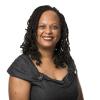
Sarah F. Cliffe is currently the director of New York University’s Center on International Cooperation. Prior to that, she was the Special Representative for the World Bank’s World Development Report on Conflict, Security and Development, and the Special Adviser and Assistant Secretary-General of Civilian Capacities to the United Nations.



